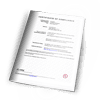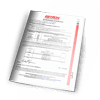VELOCITY AND TEMPERATURE SENSORS
EBTRON®’s manufacturing process requires all sensors to be independently calibrated prior to shipment using calibration reference standards set by the U.S. national standard at NIST. We first age each Bead-in-Glass thermistor for stability, then calibrate it to an industry-leading temperature measurement accuracy. We assemble two thermistors into a sensor node and calibrate each node produced in our wind tunnels at 16 velocity points.
Our airflow reference standard is calibrated at the NIST air speed wind tunnel and verified by a Laser Doppler Anemometer. The quality of this standard has proven to provide the lowest statistical uncertainty of any other method available within the required operating velocities ranging from 10 fpm to 5000 fpm.




















